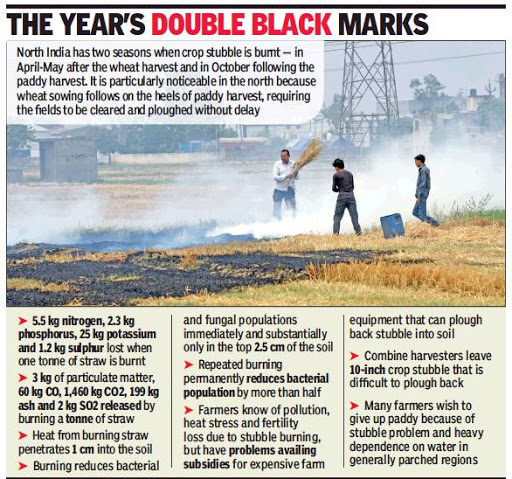Science & Technology
Stubble Waste Management
- 27 Oct 2020
- 6 min read
This article is based on “Wealth from stubble” which was published in The Indian Express on 27/10/2020. It talks about the issue of stubble burning and suggests actionable programmes to address the same.
Every winter in northern India starts with the precarious news of dangerous levels of air pollution resulting from the Paddy stubble burning. This is because the quantity of the farm waste is humongous and the window for disposing of it is too small.
The regularity of air pollution from stubble burning led the state and central government to develop business models to discourage stubble burning and promote farm waste to energy projects.
However, despite these interventions the farmers have less incentive to collect the stubble and subsequently the stubble burning issue largely remains unsolved. Therefore, stubble management should be broadly focussed on-field management, alternate cropping, processing to biofuels and proper implementation of existing schemes.
Reason For Stubble Burning
- Stubble burning is the act of setting fire to crop residue to remove them from the field to sow the next crop.
- In order to plant next winter crop (Rabi crop), farmers in Northern India have to move in a very short interval and if they are late, due to short winters these days, they might face considerable losses.
- Therefore, burning is the cheapest and fastest way to get rid of the stubble.
- Further, if stubble is left in the field, pests like termites may attack the upcoming crop.
- Also, the precarious economic condition of farmers doesn’t allow them to use expensive mechanised methods to remove stubble.
Issues in Stubble Waste to Energy
- Lax Implementation: In 2019, the governments of Punjab and Haryana announced Rs 2,500/acre as a bonus to small farmers who avoid burning stubble but there has been the negligible implementation of this scheme.
- Adverse Impact of Laws: Implementation of the Punjab Preservation of Subsoil Water Act (2009) made the time period of stubble burning coincident with the onset of winter in Northern India.
- Late transplanting of paddy during Kharif season to prevent water loss as directed by PPSW Act (2009) had left farmers with little time between harvesting and preparing the field for the next crop and hence farmers are resorting to the burning of stubble.
- Inadequate Supply as Raw Material: The costs of establishing a year-round “bankable” supply chain for paddy straw bales is another deterrent.
- Albeit with limitations related to offtake agreements, the National Policy on Biofuels was not able to achieve intended targets.
- Increasing Competition With Solar & Wind Energy: The government has actively supported the biomass power sector by provisioning for a high feed-in tariff.
- However, tariff orders for biomass gasifier/biogas power became inconsequential with solar and wind power tariffs declining to 33% of that of biomass power.
Way Forward
- On-field Management: It involves mulching the stubble into fields by customised machinery. In order to promote mulching there is a need for:
- Providing subsidy for purchasing equipment.
- Establishing Farm Machinery Banks for custom hiring of in-situ crop residue management machinery.
- Furthermore, Co-operative societies of farmers, self-help groups, registered farmers societies/farmers groups, private entrepreneurs for establishment of farm machinery banks or custom hiring centres.
- Alternate Cropping: There is a need to promote alternatives to wheat and rice, which could be the cultivation of silage crops (hybrid sorghum, hybrid napier grass, maize).
- These alternatives have a high yield, enabling farmers to meet the feedstock needs of cattle, can also be used to produce biofuels plants and the cultivated area can be interspersed with horticulture.
- Ensuring Adequate Supply with Biomass Depots: It is essential to undertake on-field baling of stubble, aggregate bales in a depot and enter into “bankable” agreements for supplies to Bio-Energy Plants.
- In order to establish a biomass depot, there should be fiscal incentives for enabling green entrepreneurship.
- Turning Stubble to Advanced Biofuels: Stubble should be used for production of gaseous biofuels like producer gas, biogas and green hydrogen.
- The Ministry of Petroleum and Natural Gas’s SATAT scheme is a step in the right direction.
Conclusion
Stubble burning poses a challenge to public health. However, by processing agriculture residues to biofuels and compost will benefit many more farmer households, with manifold collateral benefits that accrue from assured availability of sustainable energy.
|
Drishti Mains Question Effective stubble management can convert the crisis of public health into an opportunity of sustainable energy. Comment. |
This editorial is based on “An Indian SpaceX” which was published in The Financial Express on October 23th, 2020. Now watch this on our Youtube channel.





